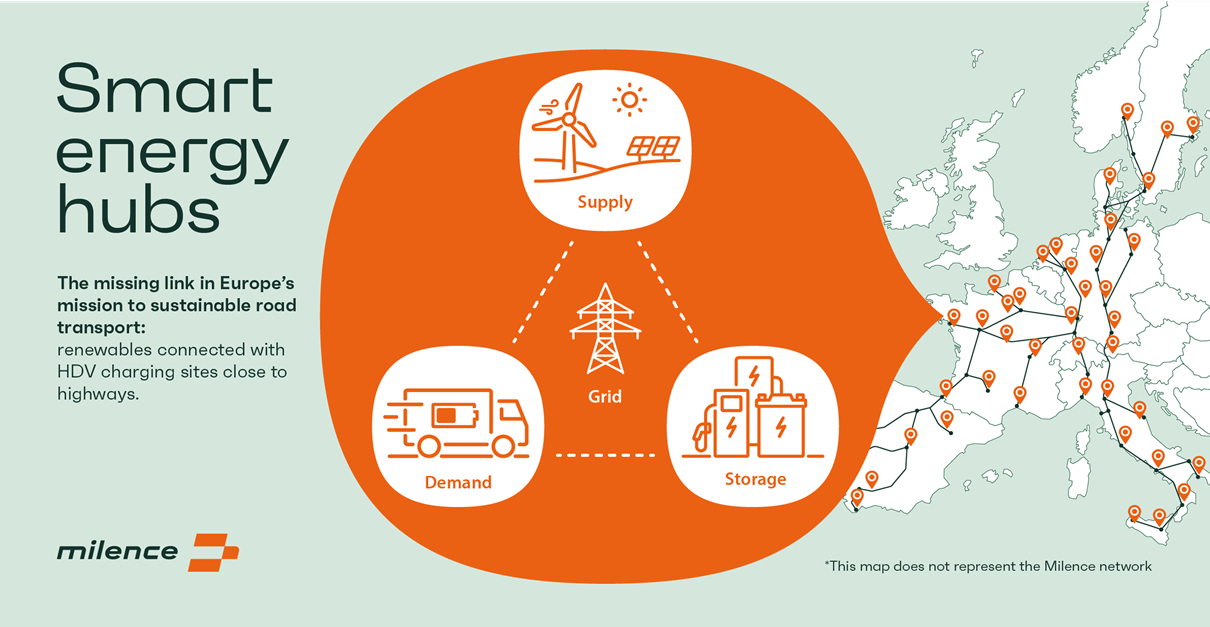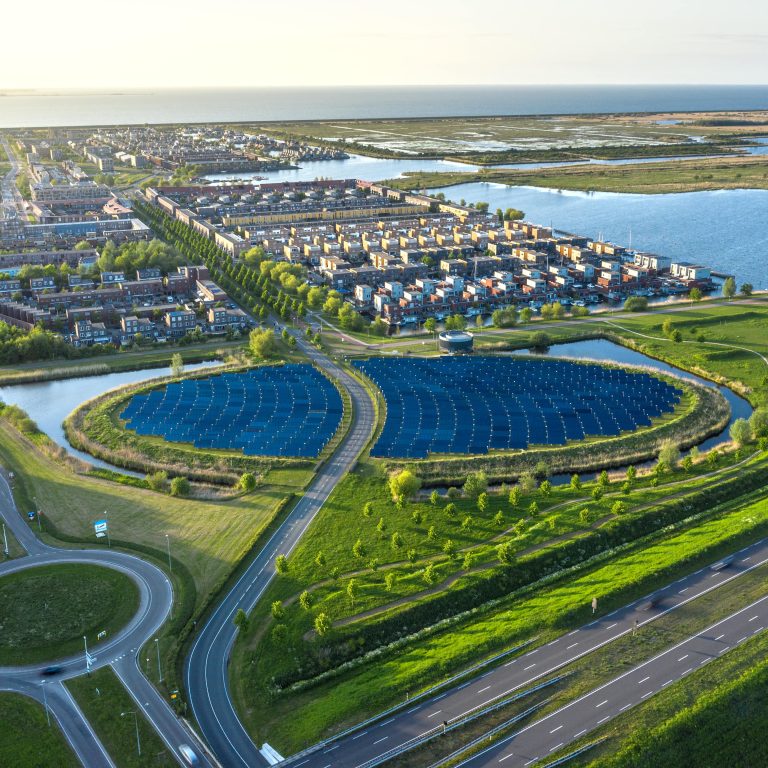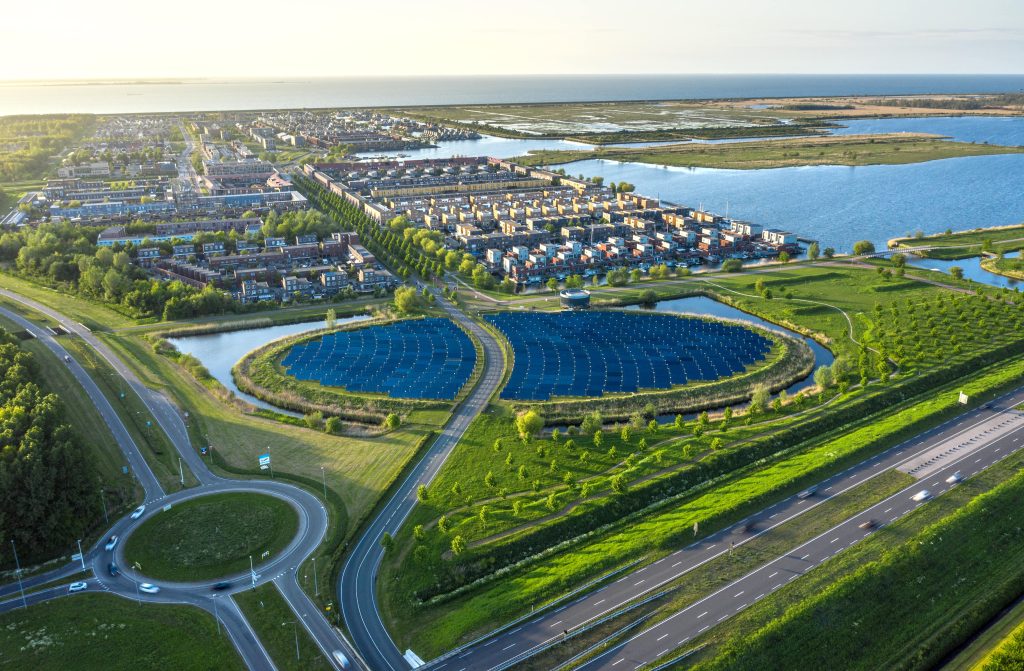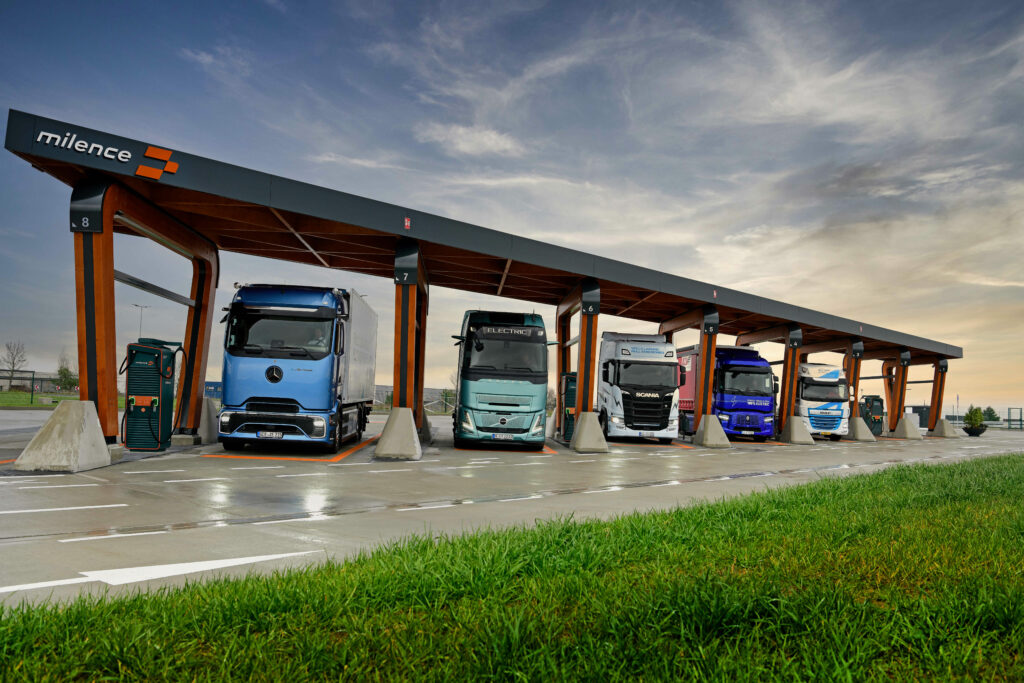In the battle against climate change, two critical fronts are emerging: the transition to renewable energy sources and the decarbonisation of transportation. New battery electric trucks are the driving force of the road transport transition. Meanwhile, the transition towards more connected renewables and electric trucks could be hampered if grid infrastructure investments do not keep up.
The solution? Smart energy hubs along highways that integrate multiple renewable energy resources, storage devices, and consumption points using advanced controls, communication, and data analytics. The goal would be to improve energy efficiency, optimise energy management, reduce costs, and enhance grid reliability.
This article explores the status quo and what is needed to accelerate both the energy and transport transitions, while explaining how data sharing drives Europe towards a sustainable future.
 The rise of renewable energy
The rise of renewable energy
Trucking currently accounts for over a quarter of the EU’s road transport greenhouse gas emissions over and more than 6% of total EU carbon emissions (link). Yet, with the transition to cleaner road transport, such as battery-electric (BE) trucks, and the increasing availability of renewable energy, we have the opportunity to drastically reshape this landscape. Distances and charging times are no longer a limitation and on top of that, the total cost of ownership (TCO) of BE-trucks decreases over time.
We have seen similar cases of rapid transformations in the transport and energy sectors before. The global share of passenger electric cars tripled the last three years, from around 4% in 2020 to 14% in 2022, and growth of the EV market is expected to continue in the coming decade.
Renewable energy sources have also gained tremendous momentum in recent years. The cost of renewable energy technologies, in particular solar and wind, has significantly decreased, making them more economically viable as replacement for fossil fuels.
The rise of solar energy and the use of passenger car electric vehicles (EVs) are prime examples of rapid adoption. They show the power of the ‘flywheel effect’ when you couple societal needs and innovation with the right political measures.
In a similar way, the rapid adoption of battery electric trucks is now moving with high speed.
The missing link? A seamless integration of renewables, batteries, and public charging infrastructure. Milence’s view is that missing link can come from smart energy hubs, connecting renewable energies to road transport, in particular for heavy-duty vehicles. These strategic hubs would serve as ‘pit stops’ for charging electric trucks with renewable energy, bridging the gap between supply and demand.
Connecting renewables and road infrastructure
Realising the electric transport transition boils down to putting in place an infrastructure transition. In essence, to enable this, we need to roll out electricity infrastructure in such a way it can seamlessly integrate generation, storage, and consumption and can manage connected assets intelligently to maximise efficiency, sustainability and are allowing renewable energy to integrate with road transport.
These new energy systems would allow the different sectors to decarbonize, a key aspect of the energy transition. Additionally, a digital ecosystem that connects all stakeholders is equally important – from energy producers and suppliers to truck drivers and fleet managers.
Overcoming roadblocks in the transition to new highways
Historically, access to electricity was not a consideration when constructing highways and other infrastructure. Bringing energy into the picture fundamentally changes things. We will soon see the rise of charging points along highways, industrial areas, depots, and rest stops where trucks park and unload.
While grid capacity expansion and reinforcement typically require a lead time of 5-10 years, the current long term planning by grid operators falls short, with grid upgrades lagging behind the demand for battery-electric trucks. Forward-looking infrastructure planning is not well coordinated with projected industrial needs and technology adoption. In addition, access to grid connection rights for both renewable generation and users can be very long, burdensome and not always transparent. This discrepancy raises uncertainties with regard to the uptake potential of e-trucks, hindering their widespread adoption.
Smart energy hubs would play a crucial role in creating physical spaces where electricity supply and demand meet, offering a solution to the present grid upgrade challenges, and providing flexibility and resiliency to the broader energy system.
Policy to connect the grid with the highways
Adapting to the evolving energy landscape requires changes at a policy level. The shift towards expanded grid capacity and the establishment of public charging infrastructures for heavy-duty trucks demands timely planning, predictable processes and public support for anticipatory investments.
Policymakers should therefore implement a holistic approach to energy and transportation. This translates into policies that stimulate joint planning and investment in infrastructure that benefits all stakeholders. Transportation agencies, local authorities and industry stakeholders should join forces to ease access to optimal locations for strategic energy hubs near major transport axes to serve the needs of BE-HDVs along key routes.
The implementation of new intelligent technologies, including smart energy management and energy storage, will be vital to manage the interaction between HDV charging hubs and on-site renewable energy generation. Financial incentives and public-private partnerships can stimulate investment in these hubs. Streamlined and priority permitting processes that expedite the approval of these type of infrastructure projects can further encourage swift deployment.
Unified standards and data sharing will reshape transportation
To ensure the optimal integration of renewables and the reliable use of HDV charging infrastructure, the whole ecosystem needs to communicate. This calls for unified standards and industry partners to share data such as vehicle metrics and interfaces between vehicle, charging point, the grid and routing systems. By analysing energy usage patterns and other relevant data, smart energy hubs can provide insights for improving energy efficiency and providing flexibility to grid operators and the wider energy system at large.
On the transport side, the impact would go beyond improving traffic events and estimated arrival times. It would lead to optimal booking of time slots at charging stations, improved charging strategies, and even preemptive, early warning mechanisms for potential issues on the road.
Overall, it would enable seamless synchronisation of transport and energy data and improve the efficiency of logistics operations and the reliability of recharging infrastructure.
How we go further….
As we work together with different partners to rethink the rest and recharge solutions along our highways, we see smart energy hubs as more than charging stations for electric trucks – they serve as important crossroads where demand and supply can meet. Through effective planning and management of renewable energy generation, storage, and charging solutions, smart energy hubs facilitate the seamless integration of clean energy into the transport sector. This will accelerate the infrastructure transition, enabling a harmonious movement of transport and energy towards a sustainable future.



